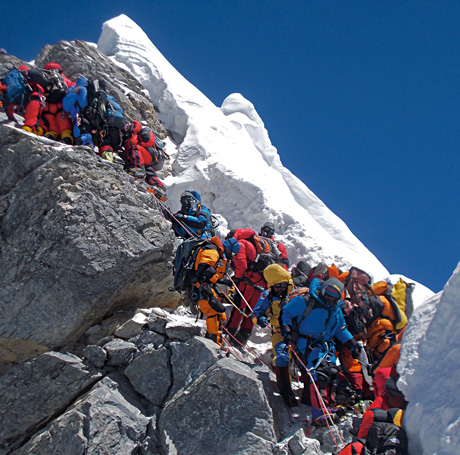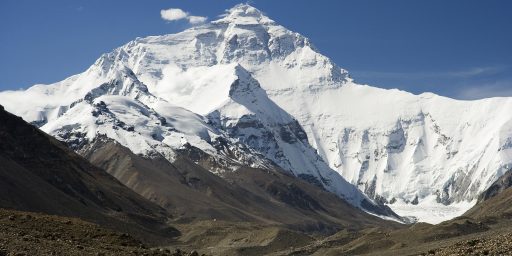Mount Everest Crowded, Littered with Corpses
Fifty years after Edmund Hillary's historic ascent, Everest is crowded with guided tours and littered with the corpses of inexperienced climbers.
Edmund Hillary made history when he scaled Mount Everest fifty years ago. Now, it’s crowded with guided tours and littered with the corpses of inexperienced climbers.
National Geographic (“Maxed Out on Everest – How to fix the mess at the top of the world“):
An hour above high camp on the Southeast Ridge of Everest, Panuru Sherpa and I passed the first body. The dead climber was on his side, as if napping in the snow, his head half covered by the hood of his parka, goose down blowing from holes torn in his insulated pants. Ten minutes later we stepped around another body, her torso shrouded in a Canadian flag, an abandoned oxygen bottle holding down the flapping fabric.
Trudging nose to butt up the ropes that had been fixed to the steep slope, Panuru and I were wedged between strangers above us and below us. The day before, at Camp III, our team had been part of a small group. But when we woke up this morning, we were stunned to see an endless line of climbers passing near our tents.
Now, bumper to bumper at 27,000 feet, we were forced to move at exactly the same speed as everyone else, regardless of strength or ability. In the swirling darkness before midnight, I gazed up at the string of lights, climbers’ headlamps, rising into the black sky. Above me were more than a hundred slow-moving climbers. In one rocky section at least 20 people were attached to a single ratty rope anchored by a single badly bent picket pounded into the ice. If the picket popped, the rope or carabiner would instantly snap from the weight of two dozen falling climbers, and they would all cartwheel down the face to their death.
Panuru, the lead Sherpa of our team, and I unclipped from the lines, swerved out into open ice, and began soloing—for experienced mountaineers, a safer option. Twenty minutes later, another corpse. Still attached to the line of ropes, he was sitting in the snow, frozen solid as stone, his face black, his eyes wide open.
Several hours later, before the Hillary Step, a 40-foot wall of rock and the last obstacle before the summit, we passed yet another corpse. His stubbly face was gray, his mouth open as if moaning from the pain of death.
How did this happen?
Everest has always been a trophy, but now that almost 4,000 people have reached its summit, some more than once, the feat means less than it did a half century ago. Today roughly 90 percent of the climbers on Everest are guided clients, many without basic climbing skills. Having paid $30,000 to $120,000 to be on the mountain, too many callowly expect to reach the summit. A significant number do, but under appalling conditions. The two standard routes, the Northeast Ridge and the Southeast Ridge, are not only dangerously crowded but also disgustingly polluted, with garbage leaking out of the glaciers and pyramids of human excrement befouling the high camps. And then there are the deaths. Besides the four climbers who perished on the Southeast Ridge, six others lost their lives in 2012, including three Sherpas.
[…]
There are other factors at work. One, ironically, is improved weather forecasting. Lack of information once led expeditions to attempt the summit whenever their team members were ready. Today, with hyper-accurate satellite forecasts, all teams know exactly when a weather window will open up, and they often go for the top on the same days.
Another factor: Low-budget outfitters don’t always have the staff, knowledge, or proper equipment to keep their clients safe if something goes wrong. The cheaper operators often employ fewer Sherpas, and those they do hire sometimes lack experience. “All of the clients who died on Everest this past year went with low-budget, less experienced operators,” says Willie Benegas, 44, an Argentine-American high-altitude guide and co-owner, with his brother Damian, of Benegas Brothers Expeditions, which has led 11 trips to Everest. Besides holding Nepalese outfitters to the same standards as international ones, the brothers say, Nepal’s Ministry of Culture, Tourism and Civil Aviation, which regulates climbing on Everest, should promote better education for Sherpas so they can perform their duties as well as international guides.
The prospects of this happening are dismal. Nepal is a poor country and the government took in over $3 million in permit fees last year and climbers brought an estimated $12 million into the local economy. The corrupt, incompetent government diverts the money it brings in, re-investing very little in safety and cleanup of Everest.







There have been private efforts to clean up the lower camps and routes, but above a certain elevation it just is not physically possible to do so without an unacceptable risk of death. This is why Everest is the world’s highest graveyard and the world’s tallest garbage dump, not to mention the worlds largest septic field.
I always wonder why people people go to places like Everest when other places like Patagonia beckon. Anyone wanting to read a great book about mountain climbing, endurance, fear, etc, I can not recommend “Enduring Patagonia” enough.
“Gregory Crouch is one such pilgrim. In seven expeditions to this windswept edge of the Southern Hemisphere, he has braved weather, gravity, fear, and doubt to try himself in the alpine crucible of Patagonia. Crouch has had several notable successes, including the first winter ascent of the legendary Cerro Torre’s West Face, to go along with his many spectacular failures. In language both stirring and lyrical, he evokes the perils of every handhold, perils that illustrate the crucial balance between physical danger and mental agility that allows for the most important part of any climb, which is not reaching the summit, but getting down alive.”
The lack of cleanup and removal of bodies on Mount Everest isn’t just about money, it’s also about the harsh conditions at those altitudes. There won’t be any cleaning crews removing garbage above 26,000 feet, and those that have died won’t get carried down (though, generally, if possible, they are pushed over the edge).
Also, there are more climbing Mount Everest and the other eight-thousanders, but fatalities per summit are down. On Everest, between 1922 and 2010 there were 4.3 fatalities for every 100 summits, but between 2000 and 2010 there have only been 1.4 fatalities for every 100 summits.
Tragedy of the commons.
I highly recommend Joe Simpson’s “This Game of Ghosts.” He has some matter of fact (and harsh) words for how Everest and other trophies are being treated.
The reason for this is that it is basically impossible to get a permit if you’re NOT part of a guide service. The Nepalese government basically never gives out permits to solo climbers or non-guided groups. And these guided clients pay generally between 60K and 100K (not sure where they got 30 from, I’ve never seen a guide service with a price that low) because THEY HAVE TO; there’s no other way to get up the mountain legally. Even world-class climbers have no choice if they want to climb the mountain. They just have to suck it up and join a guide service, and pay their 60 grand.
And there’s the fights with the Sherpas. Count me out.
I recall watching a tv program about the finding of Mallory’s body on Everest. I was struck when the narrator said there were bodies all over the place.
While this is all interesting I’m not sure I see the point.
The trash problem is simple. You check in with a list of gear, climb the mountain and then check out with that same gear. If you brought it up the mountain you bring it back down. If you can’t do that, stay the hell off the mountain.
The human waste problem is another story. However, it may actually be the solution…offending climbers to the point where they abandon Everest.
As for the people who died, there are worse ways to go than climbing Everest. I can tell you from personal experience that you are never more alive than when you are one step away from death.
Human behavior will be regulated. It will be regulated by humans or by the non-human world. There is no material difference between what is happening on Everest and the rest of the planet.
It’s one thing to participate in a marathon or a century bike ride, surrounded by thousands of other people. It’s quite something else to join the masses, as pictured above, on Everest. I begrudge those that have reached the highest point on earth nothing. They evince incredible focus and fortitude in reaching such a singular goal. It’s not for me, though.
Long ago, in the 1970s, I did want to climb Everest. Marriage, kids, a job, and the financial cost kept me closer to home, making thoughts of summiting Everest fade away.
I climb a peak or two a year, though. And on almost any day I want to, I test myself by pedaling up the steepest streets in Los Angeles. Which is to say, I summit my own Mt. Everests all year long.
Do I regret failing to climb the Mother Goddess of peaks? Not when I see a photo like the one above.